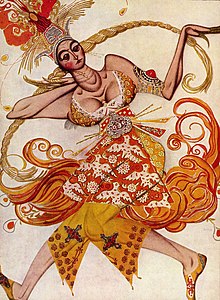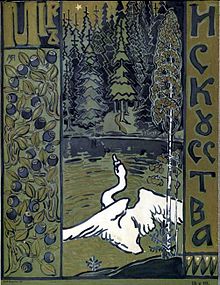Me Iskusstwa
Mir Iskusstwa ( Russian Мир искусства ; German: World of Art ) was an exhibition association of artists in Russia at the end of the 19th century and the name of a magazine that was published from 1899 to 1904 by the members of the association under the direction of Sergei Djagilew . As an artistic movement, Mir Iskusstva influenced cultural life in Russia in the first decade of the 20th century.
history
The Severny Westnik is considered the forerunner of the Mir Iskusstwa . The founders were the artist Alexander Benois and the theater maker Sergei Djagilew . The artists Léon Bakst , Mstislaw Dobuschinski , Yevgeny Lansere , Anna Ostroumowa-Lebedewa and Konstantin Somow soon joined the members .
Iwan Bilibin , Alexander Golowin , Igor Grabar , Konstantin Korowin , Boris Kustodijew , Nicholas Roerich , Walentin Serow , Michail Wrubel , Isaak Lewitan and Michail Nesterow were closely associated with the magazine .
project

The aim of the association was to take up the art standards of the outdated school of the Peredwischniki and at the same time to promote the artistic idiosyncrasies and principles of Art Nouveau . Like the representatives of romanticism of their time, the members of Mir Iskusstwa advocate the understanding and preservation of bygone art eras, especially traditional folklore and the art of the 18th century.
The projects aimed at the past were often pursued in a humorous way and in a parodistic sense. The media used light, airy effects in watercolors and gouache in conjunction with life-size oil paintings . Household items and books were designed to increase the publicity. Bakst and Benois revolutionized theatrical props with their designs by Cleopatra (1909), Carnival (1910), Petrushka (1910) and L'après-midi d'un faune (1912) after Claude Debussy .
Act
The heyday of the association extended over the period from 1900 to 1904 - during this time there was consensus on the unity of aesthetic and ideological principles. The artists held annual exhibitions between 1899 and 1903, also designing new organizational forms and doing journalism. By presenting young talented artists, Mir Iskusstwa both the association and the magazine gained a great influence on the development of the professionalism of Russian painters and printmakers at the beginning of the 20th century.
After 1904 the association expanded and lost its ideological unity. In the period 1904 to 1910 the majority of the members of the movement who entered Mir Iskusstva the Association of Russian Artists in. Since 1909, many of the Miriskusniki , as the members of the movement were called, contributed to the spread of the Ballets Russes and their ensembles that performed in Paris . After the October Revolution , the group existed until a last exhibition in 1924 without any significant influence; an attempt at renewal with an exhibition in Paris in 1927 was unsuccessful.
The "International Picture Exhibition"

Before the international exhibition of the Mir iskusstwa magazine took place in 1899, Sergei Djagilew had toured Europe for a few months. He visited private collections and ateliers of the artists, bought pictures and brokered the purchase in private collections in Russia. The transport of the greater part of the works to St. Petersburg was made possible by the art patrons Princess Marija Klawdijewna Tenischewa and Sawwa Momontow , who from 1898 financed Mir Iskusstwa in equal parts.
The exhibition was opened on January 22nd, 1899 in the rooms of the private museum, the later "Stieglitz Museum of Applied Arts" in Saint Petersburg , by Baron Alexander von Stieglitz . The exhibition catalog, which was also the second edition of the Mir iskusstwa magazine , listed 61 artists and 322 pictures and drawings. Pictures by James McNeill Whistler , the French Albert Besnard , Edgar Degas , Claude Monet , Pierre-Auguste Renoir , Gustave Moreau and Pierre Puvis de Chavannes were shown . From Germany, the exhibition showed paintings by Franz von Lenbach and Max Liebermann . Switzerland was represented by Arnold Böcklin , Italy by Giovanni Boldini , Belgium by Leon and Finland by Akseli Gallen-Kallela . Of Russian art, works by Léon Bakst , Alexander Benois , Konstantin Somow as well as Apollinarij Wasnezow , Alexander Golowin and Jelena Polenowa were shown .
literature
- Lexicon of Art . Volume III, Berlin 1981; P. 338 f.
- Kennedy, Janet: The "Mir iskusstva" Group and Russian Art 1898-1912. New York & London 1977, ISBN 0-8240-2702-7
- Klüser, Bernd and Hegewisch, Katharina (Hrsg.): The art of the exhibition. A documentation of thirty exemplary art exhibitions of this century . Insel Verlag, Frankfurt a. M. / Leipzig 1991, ISBN 3-458-16203-8 .
Individual evidence
- ↑ Lexicon of Art . Berlin 1981; III, p. 338 f.
- ↑ Ralf Beil (ed.): Russia 1900. Art and culture in the empire of the last tsar . 2008, p. 188.
- ↑ Bernd Klüser, Katharina Hegewisch (Hrsg.): The art of the exhibition. A documentation of thirty exemplary art exhibitions of this century , p. 16.
Web links
- Mir iskusstva: Serge Diaghilev's art catalog ( Memento from October 28, 2005 in the Internet Archive ) (English)
